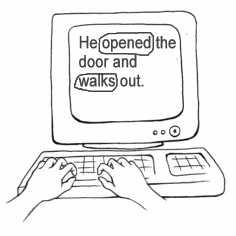A common mistake in style that I’ve seen recently is a shift in sentence style. Sometimes that means a shift in verb tense; sometimes it’s a shift in voice, mood, tone or word choice. Often there’s a shift in which point of view pronouns are being used. So that you don’t confuse your reader, keeping your style consistent throughout the paper is important.
The most common shift I see in writing is the verb tense shift.
Be consistent in your tense in your writing to avoid confusing your reader. In the picture to the right, the two verbs circled (opened, walks) reflect two different tenses (past and present, respectively). Unless you are showing a change in time within the sentence (“yesterday I opened the door, and today I walk out”), keep your verbs either all past tense or all present tense.
An example from The Everyday Writer says, “A few countries produce almost all of the world’s illegal drugs, but addiction affected affects many countries” (Lunsford 282).
Another common shift I see in writing is the shift between pronouns or number (plural vs. singular). A reminder: First person pronouns – I, me, we, us; Second person – you; Third person – he, she, it, they. This can be very confusing for your reader to follow your logic train when you shift this way.
In the above example, there is a shift from a third person pronoun (someone) to a second person pronoun (you).
To fix this, pick one point of view and stick with it. The above sentence can be rewritten to “If someone wants to play games, they must follow the rules.” This example is appropriate because I often see second person pronouns sneaking their way into essays where they don’t belong.
Finally, another common shift in writing is a shift in tone and word choice. In order to keep your tone consistent, keep the words you choose appropriate for the level of formality necessary for your paper.
If you are writing a more formal academic paper, avoid using slang or overly friendly words that will bring your reader out of the paper. For example, the following excerpt from The Everyday Writer shows a shift in tone in a formal paper about child care in America (284).
| Inconsistent Tone
The question of child care forces a society to make profound decisions about its economic values. Can most families with young children actually live adequately on only one salary? If some conservatives had their way, June Cleaver would still be stuck in the kitchen baking cookies for Wally and the Beaver and waiting for Ward to bring home the bacon, except that, with only one income, the Cleavers would be lucky to afford hot dogs. |
This example shifts in tone when the writer references “Bring(ing) home the bacon.” This phrase is too informal to fit with the assignment, and it is inconsistent with the tone of the first two sentences. A revised version below shows the appropriate formal tone needed throughout an academic paper about child care costs in the U.S. (284).
| Revised
The question of child care forces a society to make profound decisions about its economic values. Can most families with young children actually live adequately on only one salary? Some conservatives believe that women with young children should not work outside the home, but many mothers are forced to do so for financial reasons. |
There are certain genres (such as personal narrative) where a relaxed and informal tone is appropriate. Keep in mind the connotation (implied feelings) versus the denotation (dictionary definition) of words. Being cognizant of the implied feelings of words can help you keep your tone consistent throughout. If you’re writing formally, remain formal. The same can be said for informal writing. Consistency is key!
Works Cited
Lunsford, Andrea A., et al. The Everyday Writer. 5th ed., Boston: Bedford/St. Martin’s, 2013.


